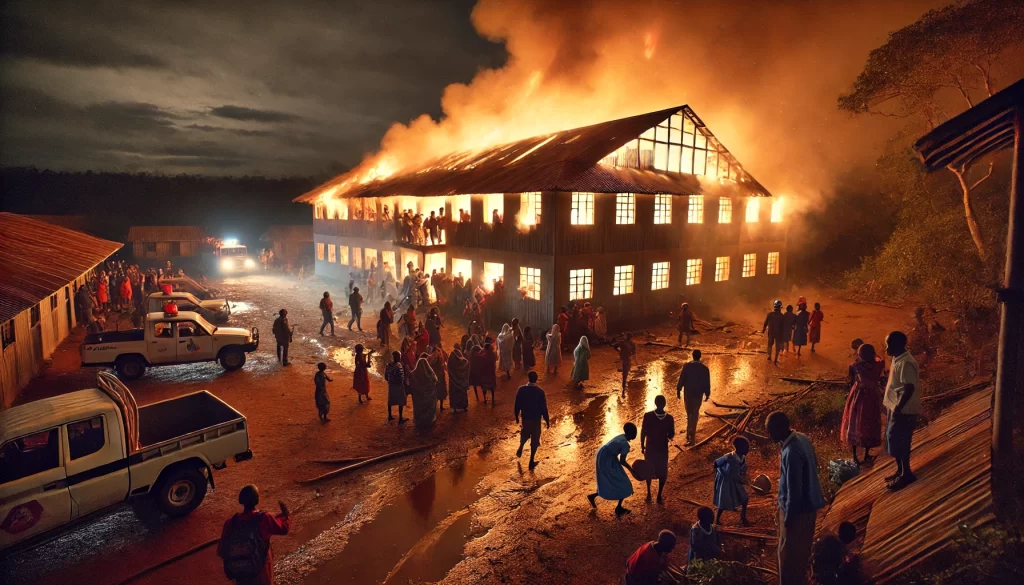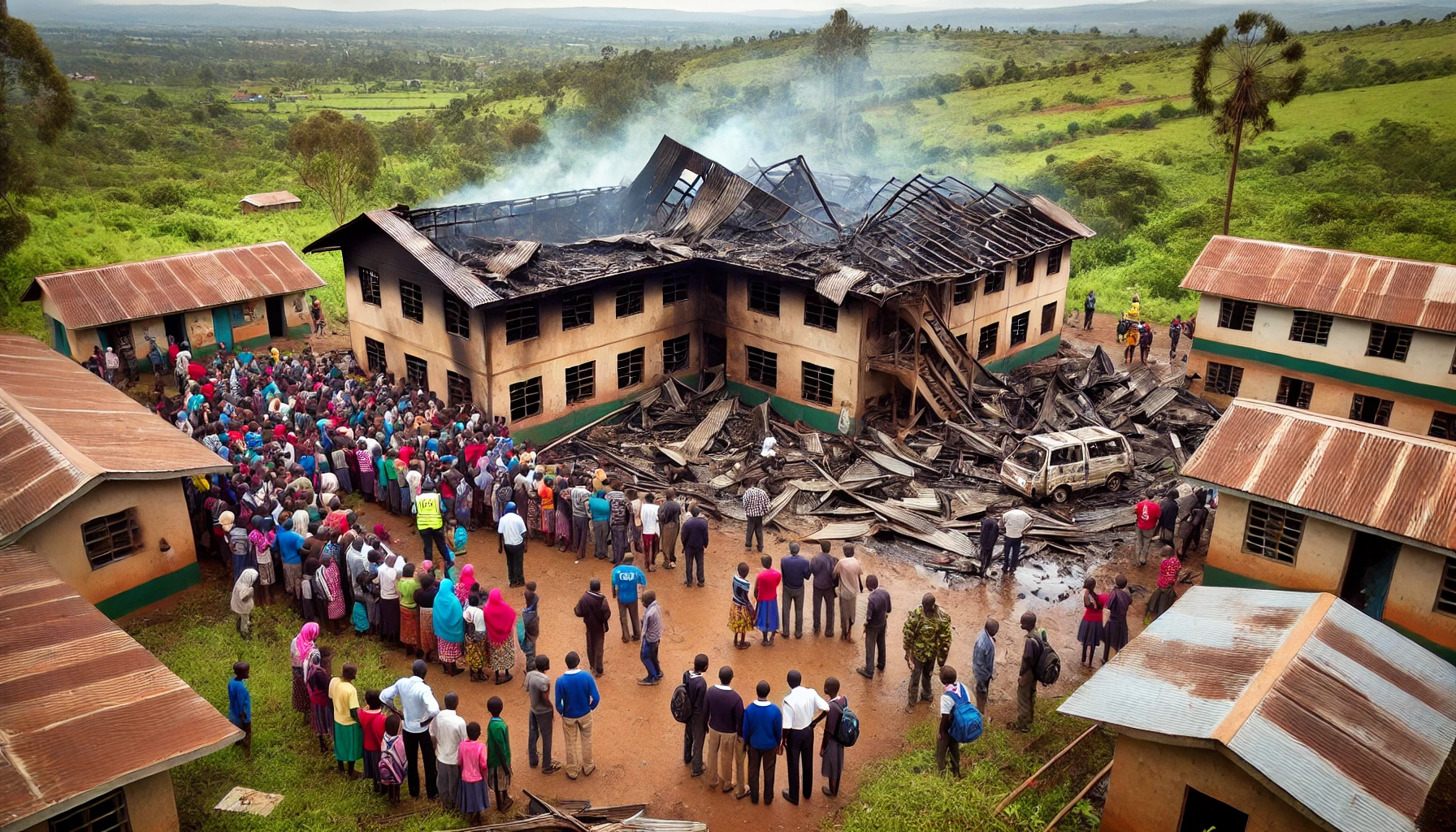A devastating fire broke out at Hillside Endarasha Primary School in Nyeri County, Kenya, on the night of September 5, 2024, claiming the lives of at least 18 students. The fire started in the boys’ dormitory, which housed more than 150 children between the ages of 10 and 14. By the next day, 27 students were hospitalized with injuries, and around 70 children were still unaccounted for, according to Deputy President Rigathi Gachagua.
The fire spread rapidly through the dormitory, which was primarily made of wooden planks, a common construction material in the area. This allowed the flames to engulf the building quickly, making it difficult for the students to escape. Local residents and parents rushed to the scene, some risking their lives to rescue children trapped inside. Many of the students were hiding under their beds when the fire broke out, and rescuers worked frantically to pull them from the building.
When authorities arrived at the school around 3 a.m., the fire had already done its worst. By morning, the flames had been contained, but the damage was severe. Sixteen students were burned beyond recognition, while another child died while being taken to a hospital. Rescue operations were complicated by heavy rains that left the roads muddy, delaying the arrival of emergency responders.
Parents arrived at the school in panic, hoping to find their children safe. One parent, John Rukwaro, expressed his devastation as he searched for his 11-year-old grandson, who was among the missing. “I have checked with hospitals, but I haven’t found him,” he said, echoing the feelings of many other grieving families. Another parent, Samson Mwangi, who had two children at the school, explained that nearby villagers were instrumental in saving some of the children, despite the intensity of the fire. “They managed to save some of the children, many of whom were hiding under the beds when the fire broke out,” he recalled.

While the exact cause of the fire remains under investigation, officials are considering the possibility of arson. Fires in Kenyan boarding schools are not uncommon, often tied to student protests over living conditions or academic pressure. In this case, the fire has renewed focus on longstanding safety issues in the country’s boarding schools. Reports suggest that Kenyan schools have a troubling history of dormitory fires, many of which have been deadly. For example, in 2001, 67 boys were killed in a fire at Kyanguli Secondary School in Machakos County. In 2017, 10 girls lost their lives in a dormitory fire at Moi Girls School in Nairobi.
Kenya’s Ministry of Education has previously issued guidelines for dormitory safety, recommending that schools have spacious dorms with two doors on each end and windows without metal grills to allow easy escape during emergencies. Fully functioning fire extinguishers and alarms are also required. However, it remains unclear whether these guidelines were followed at Hillside Endarasha Primary School. In recent years, audits have shown that many schools in the country are ill-prepared for fire emergencies, lacking basic safety equipment and training.
The Kenyan government has pledged to thoroughly investigate the incident. President William Ruto expressed his sorrow over the tragedy, calling the news “devastating.” He promised that those responsible for the fire would be held accountable. Meanwhile, Deputy President Gachagua urged the public and school administrators to strictly follow safety measures to prevent future tragedies. “We must enforce safety guidelines to avert such incidences,” he said.
The tragedy has reignited a broader discussion about the safety and management of Kenyan boarding schools, where many students board to avoid long commutes. However, concerns about overcrowding, poor living conditions, and student protests have plagued these institutions for years. The fire at Hillside Endarasha Primary School is a painful reminder of the critical need for better safety standards and accountability in Kenya’s education system.
This article is based on the following articles:
https://www.npr.org/2024/09/06/g-s1-21220/kenya-fire-school-dormitory
https://www.washingtonpost.com/world/2024/09/06/kenya-fire-school-nyeri-endarasha
https://www.nytimes.com/2024/09/06/world/africa/kenya-school-fire.html

Background Information
1. Boarding Schools in Kenya
- What are Boarding Schools?
Boarding schools are schools where students live and study. In Kenya, many children attend boarding schools to avoid long commutes from home to school. These schools allow students to stay overnight, typically in dormitories, and return home only during holidays or weekends. - Why Do Families Choose Boarding Schools?
In Kenya, education is seen as a vital path to future success, and boarding schools are often chosen by families because they provide an environment with fewer distractions. Parents believe that boarding schools help students focus on their studies by giving them more time to prepare for exams, especially since competition for jobs and higher education is intense in Kenya. - Challenges in Boarding Schools
Despite their benefits, boarding schools in Kenya face significant challenges. Many schools are overcrowded, meaning there are too many students for the available space. Overcrowding can lead to poor living conditions, and there have been cases where students have protested, sometimes resorting to setting fires in the dormitories.
2. Fire Safety Issues in Kenya
- Lack of Fire Safety Preparedness
Many schools in Kenya, especially boarding schools, are not well-prepared for fire emergencies. Dormitories are often built with wooden materials, which can catch fire and burn quickly. This makes it very difficult for students to escape if a fire breaks out. Additionally, many schools lack essential fire safety equipment such as fire extinguishers and alarms. - Kenyan Government Guidelines
To address these problems, the Kenyan government has set guidelines for dormitory safety. For example, they recommend that dormitories should have more than one exit and that windows should not have metal grills that prevent students from escaping. However, these guidelines are not always followed strictly, and this has contributed to several tragic incidents in the past. - Past Incidents
Fires in Kenyan schools, particularly in boarding schools, are unfortunately common. Some of the worst incidents include the 2001 fire at Kyanguli Secondary School, where 67 students were killed, and a 2017 fire at Moi Girls High School in Nairobi, which claimed the lives of 10 girls. Many of these fires have been linked to student protests over poor living conditions or exam pressures.
3. Kenya’s Education System and Pressure on Students
- Importance of Education
Education is highly valued in Kenya, as it is in many parts of the world, and families often make great sacrifices to send their children to school. In Kenya, the national exams that students take are extremely important because they determine whether a student can continue to higher levels of education or even get a job in the future. This creates a lot of pressure on students to do well in their studies. - Student Protests and Arson
Due to this pressure and sometimes poor conditions in schools, students in Kenya have occasionally turned to arson as a form of protest. These protests are often about the harsh conditions in schools, such as overcrowded dormitories, poor food, or strict teachers. While not every fire is caused by arson, it has become a serious issue in Kenya’s education system.
4. The Role of the Government and Safety Reforms
- Government Response to Fires
In response to the frequent school fires, the Kenyan government has investigated the causes and issued reports recommending reforms to improve safety in schools. These reports have highlighted the need for better training for school staff, regular fire drills, and the improvement of school buildings to make them safer in case of emergencies. - Fire Drills and Emergency Plans
One of the key measures that schools are supposed to implement is regular fire drills, which help students and staff know what to do in case of a fire. Unfortunately, many schools do not hold these drills, leaving students unprepared when an actual fire occurs.
5. Role of Community in Emergency Situations
- Community Involvement in Rescues
In rural areas of Kenya, local communities often play a critical role in responding to emergencies like fires. Villagers and parents frequently arrive at the scene before emergency services and help rescue students. This was seen in the recent fire at Hillside Endarasha Primary School, where local residents risked their lives to save trapped students.
6. The Importance of School Safety
Why School Safety Matters
School is supposed to be a safe place where students can learn and grow. However, when safety measures like fire alarms, escape routes, and fire extinguishers are not in place, schools can become dangerous. Ensuring that safety standards are followed in every school is vital to preventing tragedies like the one in Nyeri County.
Please subscribe to Insight Fortnight, our biweekly newsletter!
